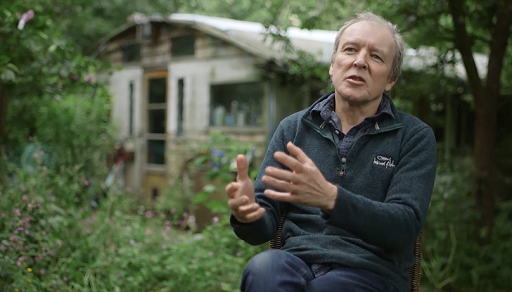3 Interview with Theo Simon
In the next video, Theo Simon, singer-songwriter of Seize the Day, talks about what motivates his activism and his commitments.
Activity 3
Watch the video now, paying particular attention to Theo Simon’s linking of celebration and protest, and his ideas about ‘spirituality’.

Transcript: Activism and reverence for nature
THEO SIMON
I don't like the word spiritual just because of the way it's been used so much, that it's become one of those words that it's hard to know what it means anymore. But for me, it's been like a spiritual path or discipline because when I'm on the front line, by which I mean any protest site where there are people trying to do something else, or trying to move me, I have to get into an awareness where I am not treating the person who's coming against me with anything but respect.
I think that non-violence isn't just a tactic. Non-violence is an attitude, which is that I respect you as another human being. It's only because of circumstances that you've ended up in a yellow jacket. And I've ended up on this side of the protest. I have complete faith in that.
On an existential level, I think that's just the truth. I do not believe that any human being is greater or lesser than me because we are all essentially-- we're all animals. And we're all connected to a bigger living process. We're not separate from it. We are actually brothers and sisters, in a very real sense. There's no way of-- and we're actually brothers and sisters to every other living thing.
These are objective realities. But they're also, I think, an experience that we can have. We do have to reconnect, which is what religion means, I think relegare to re-connect, re-bind-- something like that. And I have thought about this a lot recently. So I thought, in a way, we need a new religion.
But that's not true because religion, it's not going to work. That's over now. That's a period of our development where we've got these big monotheistic religions. Now we find there's no room left. We're all on the same planet.
But that's not to diss it because it's OK to have a framework and a story because that's all I've got, a framework and a story within which we can live. And we need that. And we need these meta stories. We need this big meaning. There is a bigger entity. Objectively, we could call it the biosphere. So science now, we can say the biosphere exists.
I don't think everyone-- I don't think scientists necessarily really grasp what that means. I don't really exist. Except this is a temporary-- this is a process occurring here. Cells are being created and recreated and falling off all the time. This isn't still. I'm not a solid being.
The water's flowing in and out. The air's flowing in and out. The Earth stuff is coming in as food, and going out as excrement. Everything's just happening here. And this is holding itself together, as organisms do, for a short period of time.
What it is that animates that, and whether there is a being beyond that, I really find that hard to even-- I live as if there is. I have a communication sometimes. I know that religious people do too. And yet that isn't, for them, embodied in the world around them necessarily. They might have it more abstractly, or more somewhere else.
I don't know where Allah or God is for people. But for me, there's a spirit. There's sometimes an entity. But I don't know if that's a part of me, if that's a part of my consciousness. But I'd say that there is an awareness which is at the heart of every single atom. There is a beingness. And that is in me.
And my consciousness, my awareness, comes from that place. I think the beauty of our situation is previously, a member of the government could stand up and say, while we all acknowledge that we need to take better care of our environment, we have to do so in a way that doesn't compromise our other need for economic growth.
And you could say that. And it's like, most people think, yeah, that kind of makes sense. But now it's so obvious that that model will kill the planet. It's like, you can't get away with that anymore. We just have to do it in the right way. We don't put it off anymore.
We've kind of put love and caring and religious values to one side. They're a matter of personal conscience. Oh, he's a Muslim. Oh, be respectful of him. He's a vegetarian because he doesn't think we should kill animals. So these things, where we kind of put it in one place, the real world now has to become the place where we're trying to embody love and care for each other, and for the world around us, or we are finished.
I only care that you show respect for me. I show respect for you. And you attempt to live in a way that shows respect for all life-- and that you realise that that is your responsibility. That's all I care about because I think if we do that, something new will emerge.
Discussion
The band has performed at many peace camps and activist events (sometimes labelled ‘protests’ but also thought of as ‘protections’), including Extinction Rebellion events.
He explains how celebration and protest weave together in the band’s activism. While he is not keen on the word ‘religion’, he is clear that devotion to the Earth infuses his songs, and in ways that might be considered ‘spiritual’. The terms ‘spiritual’ and ‘spirituality’ are often used to refer to more personal practices and experiences, in contrast to those associated with more formal or institutional ‘religion’.
This interview helps us understand how activism, protest and/or political activities can be shaped, motivated and energised by diverse religious or spiritual ideas and traditions. Precisely because it is not always easy to distinguish between culture and religion – or between religion and politics – it may be helpful to reflect further about these ‘either/or or both/and’ possibilities. The question ‘why do they do that?’ is explored further in the following sections.
